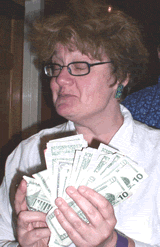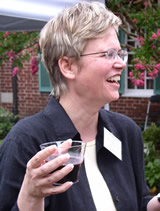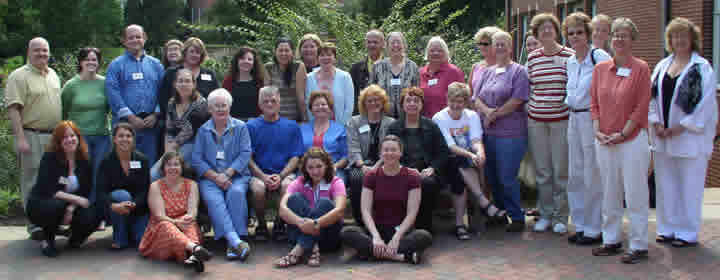 |
 |
 |
|
October 2004
News & Notices
News From:
Commissions
Conference & Stage Expo
For the Record
 |
||
| |
||
Symposium
Provided Stimulation
(And Ice Cream) |
||
|
What do President James Monroe, great Italian food, and the challenges of teaching costuming in a liberal arts setting all have in common? They are all things you experienced if you attended the 2004 USITT Costume Symposium. The symposium was held at the University of Mary Washington in Fredericksburg, Virginia. The university is the home base of Assistant Professor of Theatre Kevin McCluskey, who not only single handedly coordinated this workshop, but back in 1999 pitched the idea for this symposium to USITT. The symposium's focus was an intensive three-day program designed to strengthen teaching methods in the costume curriculum for the bachelor of arts, bachelor of fine arts, master of fine arts, and conservatory degree levels. Day one started with a meet and greet over coffee, juice, and fruit. After the requisite introductions, the symposium was off and running. From 9 a.m. until 6 p.m. on the first and third days, time was spent in working sessions. First, the group of 42 participants met as a whole and defined the challenges of that session's topic. Next, small discussion groups of six were moderated by an expert presenter. The moderators – Mr. McCluskey, Judy Adamson, Margo Shively, Martha Marking, Marsha LeBoeuf, and Holly Cole – did a great job of keeping the discussion flowing, keeping the participants on topic, never letting discussions deteriorate into gripe sessions, and inspiring creative solutions. Following these discussions, all 42 participants came together again and put forth the ideas, solutions, and strategies that emerged in the smaller group meetings. Breaking the large group down to groups of six allowed everyone a chance to explore the topics. Participants each had the opportunity to ask specific questions or offer helpful solutions in the smaller group setting. There never would have had enough time to address everyone's concerns if the large group had been the only format. Some of the topics investigated in the working sessions included:
All participants were very generous in sharing their successful solutions to various challenges. Among the examples were:
|

Holly
Cole collects the cash for the ice cream run,
a memorable part of the 2004 Costume Symposium. |
|
Mr. McCluskey arranged a few wonderful extracurricular activities to help us decompress in between the two intense days of working sessions. At the end of the first day we were invited to a wine and cheese reception generously sponsored by Danny's Warehouse at the James Monroe Presidential Museum and Library in downtown Fredericksburg, Virginia. We were treated to a private viewing of mid-nineteenth century clothing, jewelry and shoes from the Monroe family. We were even given white gloves and allowed to pick up and examine the antique clothing. On our second day we visited Richmond, Virginia (55 miles south of Fredericksburg), and were given a curator-led tour of the Valentine Museum's costume and textile collection. Several of the collection's finest antique garments and accessories were set out for us to ooh and ahh over. Next stop was a tour of the Virginia Museum of Fine Arts. The museum houses an excellent collection of Faberge eggs, as well as exquisite Art Deco and Art Nouveau furnishings and accessories. By mid-afternoon on the third day, the costumers were getting restless and insisted that, before we tackled another challenging costume topic, we should send out treats from Carl's Frozen Custard. A record-setting $73 was collected from the group for the ice cream endeavor, topped in laughs by the fact that we actually spent $75. We all know about the importance of shop treats! The symposium culminated in a group dinner the third night at Castiglia's Italian Restaurant where we had one last opportunity to get to know our new friends better and say our goodbyes and good lucks. It was another great symposium. Everyone agreed that the topic of Teaching Costuming would be a good repeat symposium, say every five years or so. It was really great to be in a room with so many costume professionals who choose to share their talent by teaching. It is also important to know that others face the same challenges, and we can gather together for a few days and talk about moving forward. Special thanks go to Mr. McCluskey for putting this together and to Renee Norris Ormsbee, Costume Shop Manager at University of Mary Washington, for her help during the symposium. |

Pat Martin, Costume Design & Technology Commissioner, enjoying the reception at the James Monroe Museum and Library. |
|
